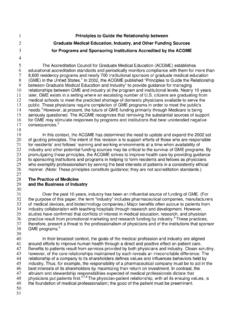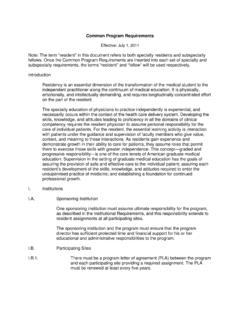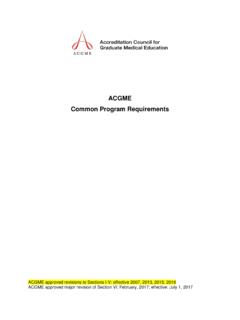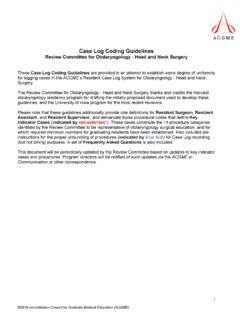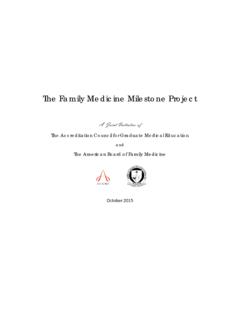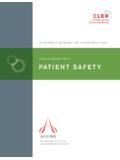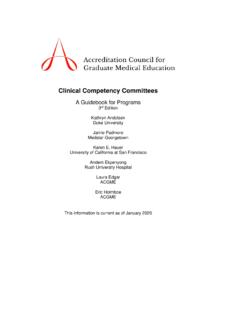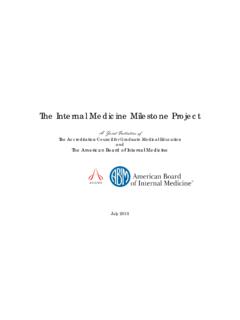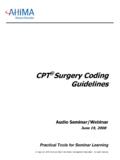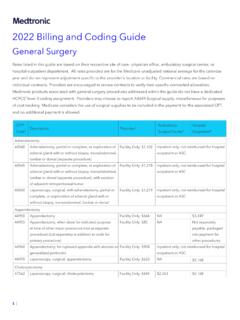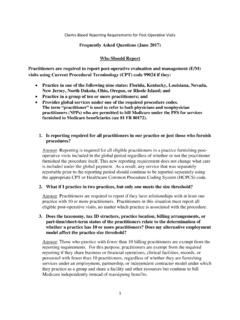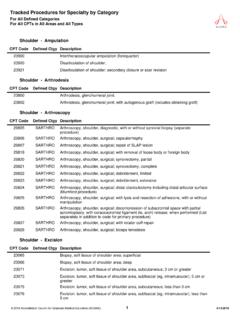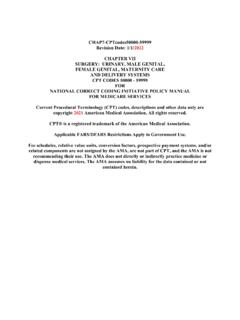Transcription of Defined Category Minimum Numbers for General Surgery ...
1 Defined Category Minimum Numbers for General Surgery Residents and Credit Role Review Committee for Surgery Defined Category minimums, and discreet cases within each Category , are in effect for residents graduating in 2018. Beginning with the January 2020 ACGME annual program review, the Review Committee will use these Defined minimums to assess graduate Case Logs. Category Minimum Skin, Soft Tissue 25. Breast 40. Mastectomy 5. Axilla 5. Head and Neck 25. Alimentary Tract 180. Esophagus 5. Stomach 15. Small Intestine 25. Large Intestine 40. Appendix 40. Anorectal 20. Abdominal 250. Biliary 85. Hernia 85. Liver 5. Pancreas 5. Vascular 50. Access 10. Anastomosis, Repair, or 10. Endarterectomy Endocrine 15. Thyroid or Parathyroid 10. Operative Trauma 10. Non-operative Trauma 40. Resuscitations as Team Leader 10. Thoracic Surgery 20. Thoracotomy 5.
2 Pediatric Surgery 20. Plastic Surgery 10. Surgical Critical Care 40. Laparoscopic Basic 100. Endoscopy 85. Upper Endoscopy 35. Colonoscopy 50. Laparoscopic Complex 75. Total Major Cases 850. Chief Year Major Cases 200. Teaching Assistant Cases 25. 05/2019. 2019 Accreditation Council for Graduate Medical Education (ACGME). Minimum Case Requirements by PGY-3. Residents must have at least 250 operations by the beginning of their PG-3 year, effective with applicants who began residency in July 2014. The 250 cases can include procedures performed as Operating Surgeon or First Assistant. Of the 250, at least 200 must be in the Defined categories, endoscopies, or e-codes (see below for information on e-codes). Up to 50 non- Defined cases can be applied to this requirement. These requirements are in effect for residents graduating in 2020, and will be assessed beginning with the 2021 ACGME annual program review.
3 E-Codes: General Surgery residents can use e-codes to receive ACGME Case Log credit for vascular surgical procedures. E-codes allow more than one resident to take credit for an arterial exposure and repair. The resident who accomplishes the exposure should add an "E" to the case ID for the system to allow credit for a second procedure on the same patient. The relevant CPT codes to use are: 35201 (Repair blood vessel, direct; neck); 35206 (upper extremity);. 35216 (intra-thoracic without bypass); 35221 (intra-abdominal), and 35226 (lower extremity). Four categories are available under Trauma for residents to enter arterial exposures. 05/2019. 2019 Accreditation Council for Graduate Medical Education (ACGME). Credit Roles for General Surgery Residents Residents must function in the role of Surgeon for a Minimum of 850 operative procedures over the five years of residency.
4 Of these 850, at least 200 must be accomplished as a Chief Resident. A resident is considered the Surgeon only when he or she can document a significant role in the following aspects of management: determination or confirmation of the diagnosis provision of pre-operative care selection and accomplishment of the appropriate operative procedure direction of the post-operative care For multi-procedure operations, residents must record all procedures performed and indicate which procedure will count as the primary procedure. When more than one resident is involved in the same patient/same day/same operation/procedure, a senior resident may take credit as Surgeon, while another resident may take credit as First Assistant; or, a senior resident may take credit as Teaching Assistant while a more junior resident takes credit as Surgeon Junior.
5 If two residents perform different procedures on the same patient (different CPT codes), then each may take credit as Surgeon. Abbreviations for use in the Case Log System SC = Surgeon Chief: Used for cases credited as Surgeon during the 12 months of Chief experience SJ = Surgeon Junior: Used for cases credited as Surgeon prior to Chief experience TA = Teaching Assistant: Used when a Chief Resident is working with a junior resident who takes credit as Surgeon Junior . The Minimum required number of TA cases may be reported during the PG-4 and 5. years. All TA cases will count toward the total major cases, and will count in the Defined categories, but will not count towards the 200 Minimum cases needed to fulfill the operative requirements for the Chief year. FA = First Assistant: Used when a resident assists another surgeon with an operative procedure and when he or she is not the primary Surgeon; FA cases are not credited toward the total number of major cases 05/2019.
6 2019 Accreditation Council for Graduate Medical Education (ACGME).
